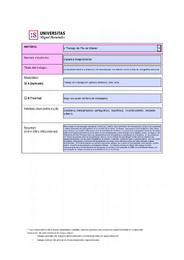Por favor, use este identificador para citar o enlazar este ítem:
https://hdl.handle.net/11000/29322Registro completo de metadatos
| Campo DC | Valor | Lengua/Idioma |
|---|---|---|
| dc.contributor.advisor | Navarrete, Carmen | - |
| dc.contributor.author | Beija Botelho, Catarina | - |
| dc.contributor.other | Departamentos de la UMH::Arte | es_ES |
| dc.date.accessioned | 2023-06-22T07:48:01Z | - |
| dc.date.available | 2023-06-22T07:48:01Z | - |
| dc.date.created | 2022-09-07 | - |
| dc.identifier.uri | https://hdl.handle.net/11000/29322 | - |
| dc.description.abstract | Este ensayo es una analogía conceptual, contextual y poética, entre el territorio del descampado y la figura de la lesbiana –ambos elementos anti cartográficos en el contexto de la ciudad neoliberal– que propone crear imágenes y abrir líneas especulativas que amplíen reflexiones sobre la invisibilización histórica y la ausencia de cartografías lesbianas. El trabajo parte de la experiencia personal de la autora en los descampados y como lesbiana en el espacio urbano. Se basa en las reflexiones de Paul Preciado sobre las características anti-cartográficas y topofóbicas de la lesbiana; en las reflexiones de Teresa de Lauretis sobre la invisibilización lésbica; en los análisis de José Miguel Cortes sobre la ausencia de geografías lésbicas y en las series fotográficas de Cabello y Carceller, Catherine Opie y Carmela García, que son objeto de análisis. Para pensar el territorio del descampado, se toman como referencia obras de Gilles Clément e Ignasi Solà-Morales. En la parte práctica se describe una acción artística que propone el descampado como espacio posible para la creación de genealogías y cartografías lésbicas. La lesbiana a la que se refiere este ensayo se sitúa históricamente entre el final oficial de las dictaduras y el comienzo de la década de 2000, en la Península Ibérica, y el descampado se refiere unicamente al localizado en el sur de Europa. | es_ES |
| dc.description.abstract | This essay consists of a conceptual, contextual and poetic analogy between the urban wasteland and the figure of the lesbian (both being anticartographic elements within the context of the neoliberal city), in order to create images and open up a speculative thought, capable of expanding reflections on the historical lesbian invisibilization and the absence of lesbian cartographies. It is based both on the author's personal experience in the wastelands and as a lesbian woman in urban space. It is based on observations from Paul Preciado regarding the anticartographic and topophobic characteristics of the lesbian; on the considerations of Teresa De Lauretis on lesbian invisibilization; on the analisis by José Miguel Cortés about the absence of lesbian geographies and the photographic series by Cabello y Carceler, Catherine Opie and Car - mela García, as an object of analysis. In order to address the wasteland territories issue, works by Gilles Clément and Ignasi Solà-Morales are used as references. In the practical part, we refer to an artistic action in which the wasteland was proposed as a possible space for the creation of lesbian genealogies and cartographies. The lesbian subjectivity mentioned in this essay is historically situated between the official end of the dictatorships and the beginning of the 2000s in the Iberian Peninsula, with the term "wasteland" referring only to the wastelands located in southern Europe. | es_ES |
| dc.format | application/pdf | es_ES |
| dc.format.extent | 68 | es_ES |
| dc.language.iso | spa | es_ES |
| dc.publisher | Universidad Miguel Hernández de Elche | es_ES |
| dc.rights | info:eu-repo/semantics/openAccess | es_ES |
| dc.rights.uri | http://creativecommons.org/licenses/by-nc-nd/4.0/ | * |
| dc.subject | Lesbiana | es_ES |
| dc.subject | Descampado | es_ES |
| dc.subject | Cartografías | es_ES |
| dc.subject | Topofobia | es_ES |
| dc.subject | Invisibilización | es_ES |
| dc.subject.other | CDU::7 - Bellas artes | es_ES |
| dc.title | La topofobia lesbiana y el territorio del descampado | es_ES |
| dc.type | info:eu-repo/semantics/masterThesis | es_ES |

Ver/Abrir:
TFM CATARINA BEIJA_compressed.pdf
1,28 MB
Adobe PDF
Compartir:
 La licencia se describe como: Atribución-NonComercial-NoDerivada 4.0 Internacional.
La licencia se describe como: Atribución-NonComercial-NoDerivada 4.0 Internacional.
.png)